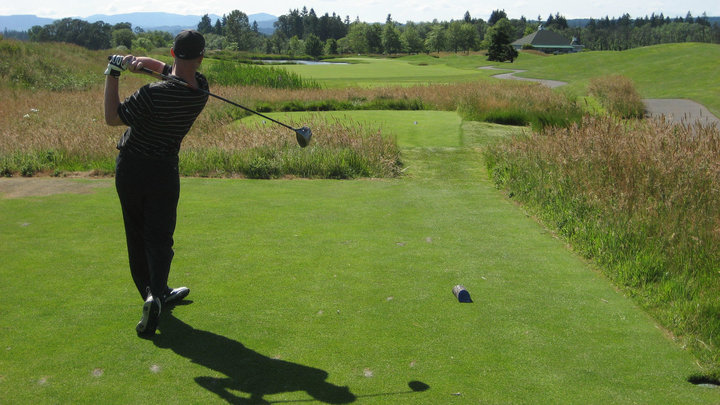Author: Tyler J. Tonso, DC CKTP FMSC

Flexibility is key with the proper golf swing.
The Chain of Events
During the golf swing there’s a number of biomechanical aspects that all have to synchronize correctly and in the right order to have a good swing. It’s a chain of events where if something is missing or done at the wrong time then it can affect several other areas of the swing and your body. One of the most common problems I see is when people don’t have enough mobility in their thoracic spine and shoulders which causes a variety of problems.
Compensating Isn’t Always a Good Thing
When people don’t have enough range of motion in their shoulders and thoracic region they either end up with a shorter back swing or compensate by over-rotating their lumbar spine. While our body naturally makes compensations when we are weak or immobile in certain areas it’s not always a good thing. A shorter backswing simply leads to less clubhead speed(power) which leads to less distance. Over rotating the lumbar spine can not only lead to golf problems but can also cause injuries.
Golf Can Cause Havoc on the Spine if Done With Improper Mechanics
Some of the worst actions on the lumbar spine consist of repeated flexion, and even worse, repeated flexion combined with twisting. Does this sound familiar? After golfing for 3 or 4 hours how many times do you think people flex forward to tee up their ball, repair a divot, mark their ball on the green, check to see if the ball is theirs, get more balls out of their bag?…you see where I’m going. Then combine all that flexion in the low back with repeated twisting over 100, or 200 times if you include practice swings and warming up on the driving range. This can take its toll on a healthy low back with no problems let alone if someone is already dealing with back pain.
Helping Your Game As Well As Your Back
So what can be done to help? Obviously we don’t want to just quit golfing altogether but there are some things that can be done to help minimize the pain and compensating factors.
- Stop carrying your bag on your shoulders. This is wrong for so many reasons. The added compression on all the discs of the spine is undoubtedly going to eventually cause some kind of pain, especially with all the repetitive flexion and twisting motions while golfing. Also, the added weight on the upper back makes us hunch forward which over time decreases our thoracic range of motion gradually as we do this for several hours. Ever notice how your game gradually gets worse throughout the round? This could be a factor.
- Work on thoracic and shoulder mobility. Pretty simple, if we have enough range of motion in our shoulders and thoracic spine then we won’t have to compensate with our low back. This can both help the golf swing and decrease the chances for injury. Increased mobility can be attained with specific stretches, foam rolling, chiropractic manipulation, and functional mobility training. Typically thoracic extension and shoulder external rotation with abduction is key with increasing the mobility during a golf swing. Adding mobility training and stretching to a workout routine would only add another 5-10 minutes of time but can have huge benefits.
- Learn how to hip hinge. This is more a preventative measure while golfing to decrease your chances of injury and muscle spasm. I don’t know how many people I see that come in with muscle spasms and low back pain the day after golfing and they say they are bending properly with their knees instead of their low back. It’s not about the knees and low back with bending over, the key is focusing on bending properly from the hips, and with golf it’s even better to learn the one legged hip hinge as seen in this video. Learning to properly hip hinge will help you when picking up balls, teeing up, and with getting your ball out of the hole after a hole-in-one.
There’s of course several things we can change in a golf swing to help someone’s specific mechanics but these tend to be the most common problems I see. If you want to learn more about the mobility work and stretches to help you specifically, then feel free to contact us.
